7.2 Flower Morphology
Learning objectives
By the end of this lesson you will be able to:
- Identify the parts of a flower.
- Describe how the whorls of floral parts are related to leaves emerging from nodes on a stem.
- Describe ways in which flower structure affects pollination.
General introduction to flower parts
The angiosperm flower is built upon a structural foundation consisting of a compressed stem with four nodes and three internodes. For a visual image of these compressed nodes, imagine pushing down on a telescoping radio antenna so that the antenna sections slide down into each other. At the very top of the fully compressed antenna you’ll still see the tips of each of the sections of the antenna, and this resembles the highly compressed nodes and internodes of a stem. The region of the stem containing these four compressed nodes is called the receptacle.
We have seen other examples of compressed stems with very short internodes, including the basal plate of the onion. In each of these cases we find leaves attached to these tightly compressed nodes. In the onion, the leaves are modified for water and nutrient storage as bulb scales. In the dandelion, the leaves are unmodified, but are arranged in a low-growing rosette. The flower is another example of a very compact stem with four nodes and three internodes. The leaves on this stem are highly modified to serve a reproductive function. They are so highly modified that, except for the structures at the fourth node, the parts don’t resemble leaves at all.
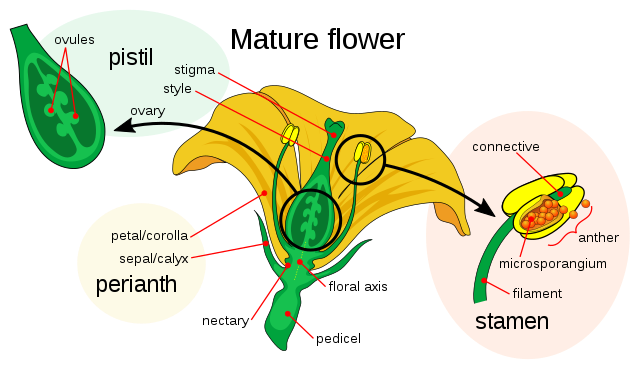
You will read and learn both the term carpel and the term pistil. You can use either carpel or pistil in this course, but we’ll usually say carpel. Pistil is sometimes still used for the structure if it is composed of two or more fused carpels.
The flower is actually a shortened branch containing a stem with four very compact nodes. This short stem is called the receptacle. From the nodes on the receptacle emerge four different kinds of modified leaves that collectively have these names:
- Calyx: the fourth node, at the base of the receptacle, individually called sepals; these are the parts that still bear some resemblance to leaves
- Corolla: the third node, individually called petals
- Androecium (Greek derivation meaning “men’s house”): the second node
- Gynoecium (Greek derivation meaning “women’s house”): the first node at the tip of the receptacle
For clarity, instead of using a number to refer to a particular receptacle node, we’ll use the name of the modified leaves attached to that node. For instance, we’ll call the fourth node where the calyx is attached the “calyx node,” the third node where the corolla is attached the “corolla node,” and so on.
We’ve noted that the calyx, corolla, androecium, and gynoecium are modified leaves. This may be surprising because, in particular, the androecium and gynoecium are highly specialized for sexual reproduction.
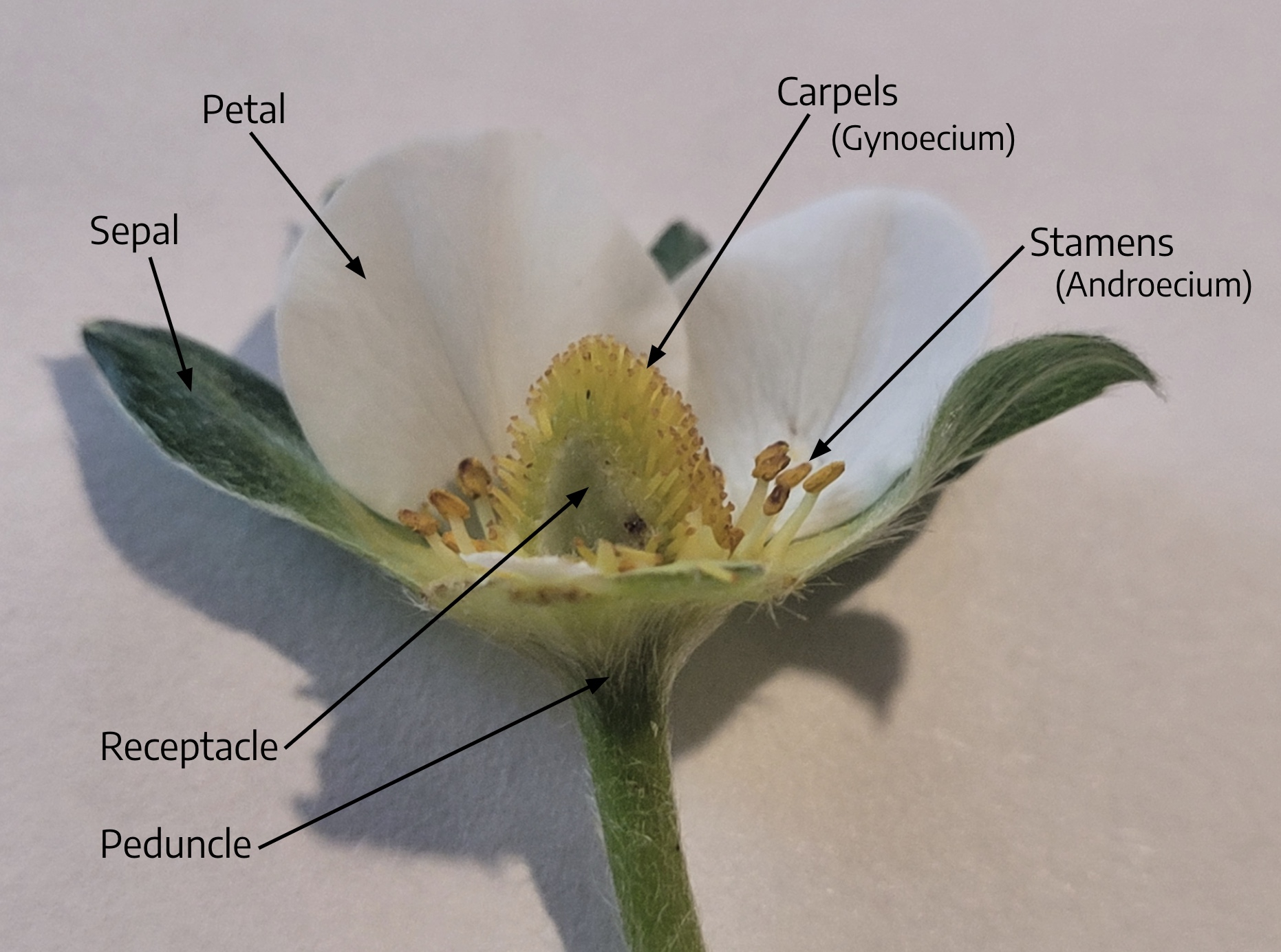
The nodes where these modified leaves are attached are often called whorls since usually two or more of these modified leaves are attached radially around the node. Monocots generally have three modified leaves attached at each node, while dicots usually have four or five attached at each node. One interesting feature of the strawberry flower shown above is the enlarged gynoecium node of the receptacle that is covered by carpels. The receptacle will become the red culinary “fruit,” while the actual botanical fruits will be the achenes (you’ve considered them seeds, but they are a type of fruit) embedded into the outer surface of the receptacle.
Watch the next two videos to learn more about flower parts and about the specialized florets of an Asteraceae flower.
Watch this video on flower structure.
Watch this video to explore the structures of an Asteraceae flower.
Review questions
- What is the receptacle?
- Draw a flower and label the parts, including the nodes.
- What is the relationship between a whorl and a node? In what way is this relationship connected to the concept that a flower’s corolla is made up of modified leaves?
Calyx
The fourth whorl at the base of the receptacle is the calyx whorl. The calyx is made up of modified leaves called sepals. In some species the sepals look like miniature leaves; they are green and photosynthetic. In other species, like the lily, they are showy and almost indistinguishable from the petals. When sepals and petals are showy and indistinguishable, they are called tepals.
The saffron flower, below, is the source of the rare spice gathered from the long, red-orange stamens that you can barely see inside the opening flower. Notice that there are apparently no sepals. That is because the three sepals and three petals of this monocot plant look the same; they are therefore tepals.
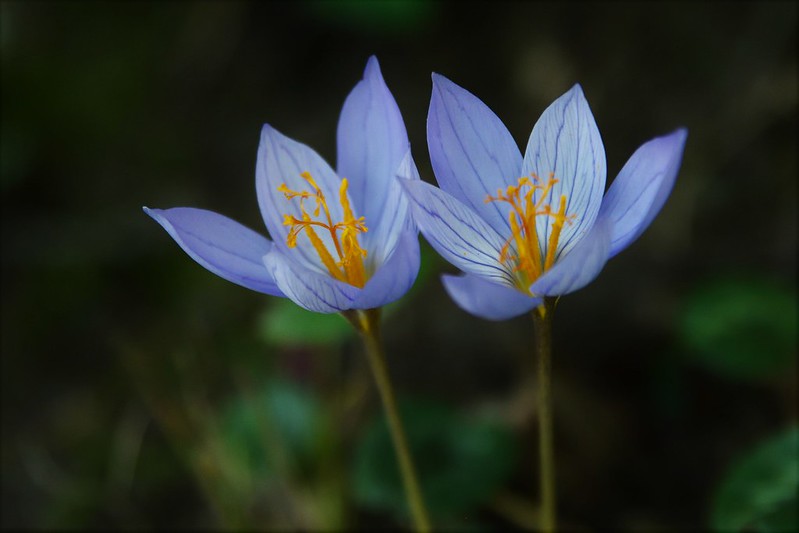
It may interest you to know that saffron is a geophyte that grows from a corm. We introduced geophytes in a previous lecture as plants that develop underground organs that allow the plant to survive during periods of hostile environmental conditions.
Watch this video on tepals.
Corolla
The next whorl toward the tip the receptacle bears the corolla. The corolla is composed of highly modified leaves called petals. Petals attract pollinators through their bright colors and showy patterns. Petals may also exude nectar near their site of attachment to the receptacle to reward insects who visit the flowers and, when doing so, spread pollen from flower to flower. Color patterns on the petals may simulate a “bulls eye” or landing strip that provides the insect with a visual guide pointing to the location of the nectar, as in the violet, below.
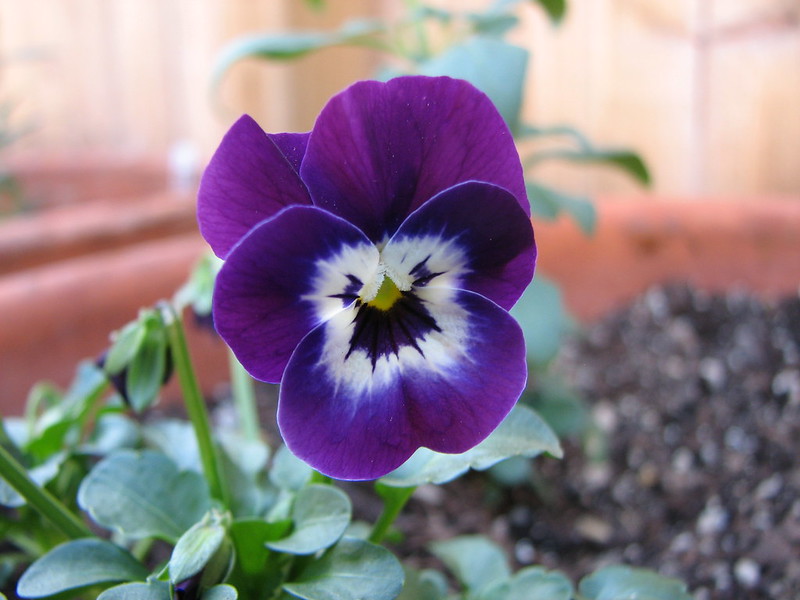
The calyx and corolla are collectively named the perianth. Some flowers lack a perianth. Corn is an example; it is wind pollinated and has no need for a showy perianth to attract insect pollinators.
Review question
- Sepals and petals are modifications of what other plant structure?
Androecium
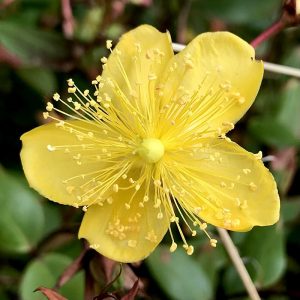
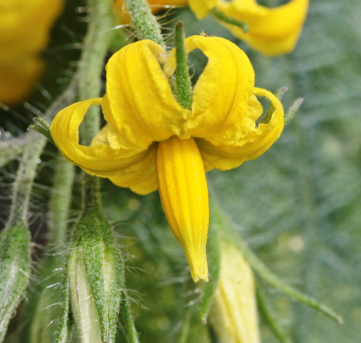
The third whorl as we move towards the tip of the receptacle is the androecium whorl. The androecium is composed of modified leaves called stamens. Stamens are found in many different arrangements. The picture of the Rose of Sharon flower, in the top photo above, shows an androecium composed of an abundance of stamens in an open arrangement. In contrast, the 10 stamens in the tomato androecium (bottom photo above) are fused into a cone that surrounds the gynoecium. The tomato’s cone of stamens is a structure through which the tomato encourages self-pollination. It is difficult for pollen from another plant to get to the stigma of the carpel before pollen from the flower’s own stamen.
Stamens have two distinct components:
Filament (a long stalk)
- The filament has an architectural function, in that it lifts the anther to a position where it can effectively release pollen grains into/onto the pollinator.
- It also has a physiological (or some might say plumbing) function, in that it connects the anther to the plant’s vascular system so that it can receive water and nutrients.
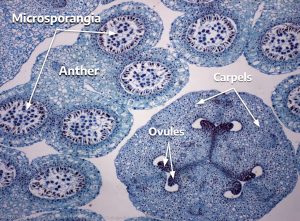
Anther (usually four sacs containing pollen grains).
- Inside the pollen sacs are microsporangia and microspore mother cells where a special type of cell division called meiosis takes place (to be covered later). Meiosis in the microsporangia leads to formation of the male gametes (sperm) that will be packaged in a pollen grain.
The image above shows a cross section through a developing flower, showing components of the androecium and gynoecium.
Gynoecium
The whorl at the tip of the receptacle supports the gynoecium. The gynoecium is composed of carpels. Several carpels may be fused into a compound carpel (which may also be called a pistil). The Berberis (Oregon Grape) flower on the right has a fused carpel; the photo clearly shows the locule (inner chamber) with the ovules.
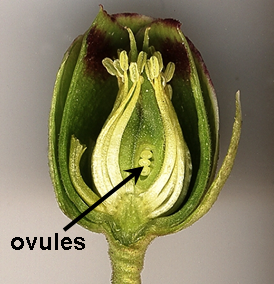
As you saw in the tutorial, the carpel consists of three parts:
Stigma
A tip on the end of the structure called the stigma.
Style
The stalk that elevates the stigma.
Ovary
The swollen base, which includes:
- A chamber called a locule
- Inside the locule, one or more ovules
- Inside the ovules, an embryo sac — the megasporangia and megaspore mother cells, which when fertilized by pollen the ovule become a seed
- Meiosis of megaspore mother cells in the embryo sac leads to the formation of the female gametes (eggs)
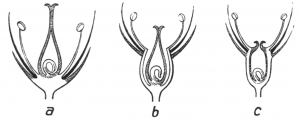
When you begin to compare structural differences among flowers, you will find that the position of the calyx and corolla relative to the ovary differs between some species. A more complete description of that relative alignment can be seen in the picture above, and is described here:
Epigynous flowers
Other flower parts are attached ABOVE the ovary.
This is called an inferior ovary because the gynoecium node isn’t positioned right at the tip of the receptacle, but rather is sunken down into the receptacle below where the androecium, calyx, and corolla are attached. This means that the ovary is surrounded by other tissues, primarily receptacle tissue. This will have an impact on whether any accessory plant tissues make up the fruit. More on that later.
Perigynous flowers
The ovary is surrounded by the fused bases of flower parts (calyx, corolla, androecium) that surround the ovary.
Hypogynous flowers
Other flower parts are attached BELOW the ovary. This is called a superior ovary because the ovary sits above the point of attachment of the top whorl.
A flower that has all four of the parts described above — Calyx, Corolla, Androecium, and Gynoecium — is called a "complete" flower. Flowers missing one or more parts are described as “incomplete.” We noted earlier that corn produces a flower without perianth. Such a flower could be described as “incomplete.”
Review questions
- Sperm are produced from microspores contained in what plant part? To which whorl is this part attached?
- Eggs are produced from megaspores contained in what plant part? To which whorl is this part attached?
- Which type of ovary is shown in the tutorial graphic at the beginning of this lecture from which you learned the parts of the flower?
- In what way does the filament of the stamen have an architectural function? How might this make a difference to the plant’s reproduction?
Pollination patterns
A flower with both androecium and gynoecium — that is both male and female parts — is called perfect or bisexual or hermaphroditic. Perfect flowers may be capable of self-pollination. Pollen produced within the flower may fall on a stigma in the same flower, and the sperm that it carries may fertilize the egg in the ovule. Sometimes, the timing of events during the stages of flower maturation encourage self-pollination. For instance, in some species the anther matures and pollen is shed, and the stigma is receptive, before the flower even opens. This is called cleistogamy, and is common in self-pollinating agricultural crops. Self pollination is encouraged because it is difficult for pollen from another flower to get to the stigma within a closed flower before pollen from the flower’s own anther gets there first. Flowers that are fully open when mature are chasmogamous and facilitate pollination from other flowers.
On the other hand, the development timing of male and female organs in a different species might encourage outcrossing by releasing pollen when the stigma in the same flower is not receptive, or vice versa. This relative timing is called Protandry when the pollen is shed before the stigma is receptive, and Protogyny when the stigma is receptive prior to pollen shed.
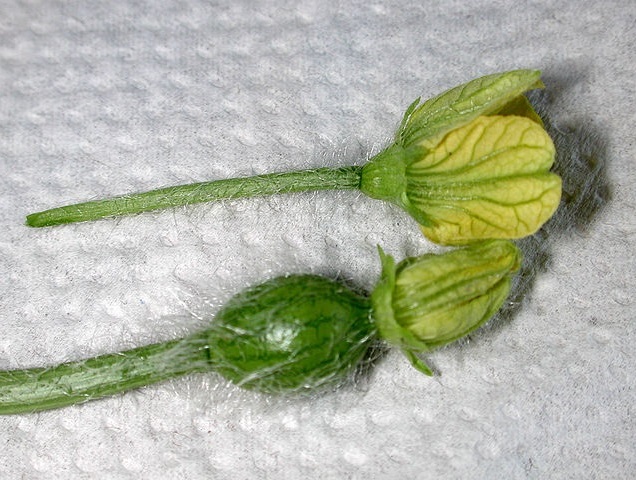
There are also genetic mechanisms called self-incompatibility, through which the stigma and style recognize pollen produced by the same plant and stop fertilization, thereby avoiding self pollination and promoting mixing genetic material (DNA) from diverse individuals.
Some plants produce imperfect male and imperfect female flowers on the same plant. The flowers containing only androecium are called staminate (male) flowers while the flowers with only gynoecium are called pistillate (female) flowers. Squash and melons, such as the watermelon shown above, are examples of plants with imperfect flowers. Corn and cucumber are others. Notice the enlarged receptacle and inferior ovary at the base of the pistillate flower of the watermelon. These flowers, because they are missing one of the four parts, could also be described as incomplete.
For the ultimate avoidance of self pollination, some plants have only staminate or only pistillate flowers. A single-sex plant like this is called dioecious (plants with both sexes, whether perfect or imperfect flowers, are called monoecious). Hops, asparagus, and hemp are examples of dioecious crop plants.
Review questions
- Which floral characteristics or patterns of timing favor self-pollination?
- Which floral characteristics favor cross-pollination?
- When you eat asparagus, is the plant part you are eating more likely to be male or female? Why?
Base of the flower where the floral parts are attached.
Composed of three parts: stigma, style, and ovary.
Term used when several carpels are fused together.
One of the whorls of a flower and is located at the base of the receptacle and contains all the sepals.
Outermost whorl of the flower that protects the flower and photosynthesizes.
One of the whorls of a flower consisting of all the petals.
Modified leaves that make-up the corolla; they are showy and attract pollinators.
One of the whorls of a flower and is all of the male reproductive parts; stamens.
One of the whorls of the flower and is all of the female reproductive parts; carpels.
Node on the receptacle where the four types of modified leaves are attached (four whorls of a flower).
When the sepals and petals are showy and indistinguishable.
Modified leaf and collectively they make up the androecium. A stamen is made-up of the anther and filament.
Both the calyx and corolla.
When the pollen from the plant pollinates the stigma of the same plant.
Receptive apex of the carpel of a flower, on which pollen is deposited at pollination.
The stalk that holds up the anther so that pollen grains can be effectively released.
The pollen-bearing component of the stamen.
The part of the ovary that contains an embryo sac and is surrounded by the nucellus, which develops into a seed after fertilization.
A chamber in the ovary.
Part of the carpel and contains ovules which develop into seeds.
When the perianth and androecium are attached below the ovary; also called a hypogynous flower.
Where all four whorls are present: calyx, corolla, androecium, & gynoecium.
The term used for flowers missing one or more of the four whorls.
Term used for a flower that has both the andreocium and gynoecium; also called hermaphroditic or bisexual.
The term used for a flower that has both the androecium and gynoecium; also called hermaphroditic or a perfect flower.
The term used for a flower that has both the andreocium and gynoecium; also called a perfect flower or bisexual.
When the anther matures, pollen is shed, and the stigma is receptive before the flower opens; it's common in self-pollinating crops.
When the anther matures after the flower opens and pollen is shed before the stigma becomes receptive; it's common in non self-pollinating crops.
When the pollen is shed before the stigma is receptive.
When the stigma is receptive prior to the pollen shedding.
When there are genetic mechanisms that inhibit self-pollination of a flower.
Part of the carpel that elevates the stigma to a position for reception of pollen and is a conduit for pollen tube growth.
When an imperfect flower only contains the androecium.
When an imperfect flower only contains the gynoecium.
When the perianth and androecium is positioned above the ovary; also called an epigynous flower.
When an entire plant has only male or only female flowers; means two houses.
When an entire plant has both male and female parts (can be perfect or imperfect); means one house

